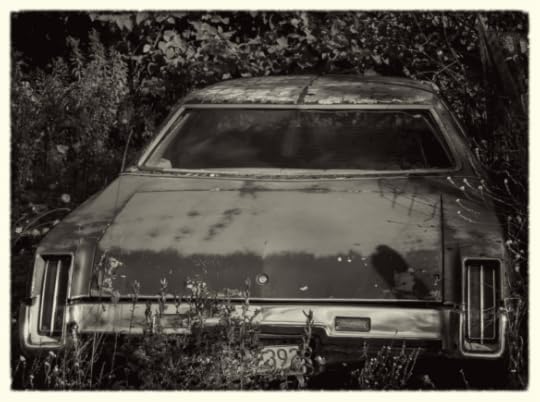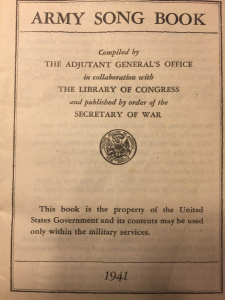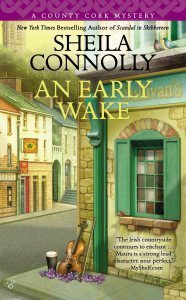Sherry Harris's Blog, page 27
February 13, 2015
Opening Lines — And the winner is…
 Congratulations to Dixie Kurtz for winning our Opening Lines photo contest. Dixie started taking photos in 2007 when her daughter was on a crew team. Regretfully she didn’t get off the automatic settings until she found herself on the football field when her son played in high school.
Congratulations to Dixie Kurtz for winning our Opening Lines photo contest. Dixie started taking photos in 2007 when her daughter was on a crew team. Regretfully she didn’t get off the automatic settings until she found herself on the football field when her son played in high school.
Dixie realized then she knew nothing about photography. So she studied  and took some classes which made all the difference. After football was over Dixie felt lost but she lives along the Mississippi River on the Iowa side of the Quad Cities. Eagles migrate every winter through the area and that became her new “thing”. Unfortunately the worse the weather the better eagle action! Dixie says, “It’s sometimes brutal but so worth it! So yes, Eagles are my thing!”
and took some classes which made all the difference. After football was over Dixie felt lost but she lives along the Mississippi River on the Iowa side of the Quad Cities. Eagles migrate every winter through the area and that became her new “thing”. Unfortunately the worse the weather the better eagle action! Dixie says, “It’s sometimes brutal but so worth it! So yes, Eagles are my thing!”
Thanks to our panel of judges and all the people who entered. We will be using some of their photos in future. Here is the winning photo:
Edith: I told her the paint wouldn’t cover the bullet hole in the trunk, and that she shoulda drove it further into the woods. But them South Lick police ain’t found it yet in all these twenty years, and I reckon I’m safe. So’s Sadie’s skeleton right there behind the hole. I know – I check on her every year on her birthday, just like today.
Julie: It’s what we in New England call a summer car. Barely running, only used three months of the year. So what was the guy doing in a snow suit? In the trunk?
Jessie: Tammy said she wouldn’t be caught dead in his car. Just goes to show how wrong you can be.
Sherry: I’d always heard my great uncle Joe got so drunk one night he pulled over to let the bridge pass. He survived but his car wasn’t found until years later when they started clearing the brush for a new hotel.
Barb: The house was completely overgrown, and so was the driveway, which appeared to be swallowing the sedan still parked at the end of it. It was as if time had stopped, and I couldn’t stop wondering why the residents had left, and why they had and never returned.
Liz: No one believed that my sister hadn’t run off with her latest loser boyfriend until a couple of kids found her car one day years later, completely by accident, buried under some brush.
Readers: Add your opening line!
Filed under: Opening Lines Tagged: abandon cars, eagle migration, mississipi river, opening lines, Quad Cities, South Lick

February 12, 2015
Second Helpings
***Breaking news alert. We interrupt this blog post to announce (with glee) that our monthly blogger and Wicked Accomplice Sheila Connolly’s newest book, An Early Wake, will debut on the New York Times Mass Market Paperback Bestseller List at #10 on Sunday!!! We now return you to our regularly scheduled posting. (After an appropriate amount of squealing and dancing around.) CONGRATULATIONS, SHEILA!***
Jessie: In NH huddled under a mohair and wool blanket with nothing but her typing fingers sticking out
Every writer I know, not surprisingly, has a lot of books. Books heave and bulge and topple from our shelves and tables. They form perilous stacks behind doors and in corners. They lurk under beds and amongst the dry goods in the pantry. For me, all of this seems perfectly natural and as things should be. Over time, however, I’ve become better at culling the herd, at ruthlessly donating to my local library and to charitable organizations that seem happy to receive them. I’ve come to pride myself in how well I feel I manage my personal library.
 So it was a surprise to me when recently a visiting friend looked round my office and asked if I really needed all the books I kept in there. I actually gasped out loud before assuring her that I did. Later, when she’d gone, I stood in front of my bookshelves and considered if I had told the truth. Certainly, I did not need them if need could be defined as food, clothing and shelter. Fewer than half of them were reference books so I couldn’t even claim they were directly used in my work.
So it was a surprise to me when recently a visiting friend looked round my office and asked if I really needed all the books I kept in there. I actually gasped out loud before assuring her that I did. Later, when she’d gone, I stood in front of my bookshelves and considered if I had told the truth. Certainly, I did not need them if need could be defined as food, clothing and shelter. Fewer than half of them were reference books so I couldn’t even claim they were directly used in my work.
What I came to realize as I stood there considering them was that they are mostly re-reads. I have read the majority of them more than once and plan to do so again. I do have a stack of to-be-read books and also books on loan from the library and from friends but mostly the books on my shelves are like favorite foods. I devour them with immense pleasure and then wait awhile before feasting on them again to better enjoy the taste. I would never consider not eating something ever again because I had already enjoyed it. For me both books and meals are about nuance at least as much as novelty. I delight in second helpings of each.
So readers, are you re-readers too or do you find there are so many wonderful books out there that you never look back?
Filed under: Jessie's posts Tagged: Books, bookshelves, culling, donating books, re-reading

February 11, 2015
Wicked Wednesdays — Our Worst Hair-dos
Okay, Wickeds pull out those photo albums. Whose mom cut their bangs too short? Who had big hair in the 80’s or bad perms? Mohawks? Anyone had the same hairstyle forevah? Feel free to share more than one.
Edith: H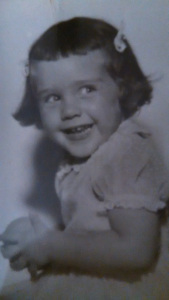 a! Talk about short bangs. Here am I about age three or four.
a! Talk about short bangs. Here am I about age three or four.
I rather liked my hair during high school, even though I slept with 3-inch diameter plastic rollers, my pillow tucked underneath them. But then there was the summer during college when I was a nanny at the beach for a month in 1973. I cut my hair, which had been below my shoulders for years, to what I thought would be an easy short cut. Disaster! Had to start pinning the bangs to the side so they could grow out. Argh. Good thing hair grows… It got long again, but for the last twenty years I’ve pretty much had the exact same hairstyle.

The unfortunate hairdo with, L-to-R, my cousin Paul, my aunt Jo, and my cousin Andy. A couple of pairs of unfortunate pants, too!
Jessie: During the summer between second and third grade my mother cut my little sister’s long hair to shoulder length and she looked adorable. She looked so nice I wanted my mother to cut mine too. My mother, wisely, refused saying my hair was nothing like my sister’s and it would not look the same. Not being one to take no for an answer I kept asking until I drove her crazy and she chopped it off. It looked bad enough that there are no photos of me during that time period at all. I’ve never worn shoulder length hair again.
Barb: I feel like I’m getting way with something because all my photos are up north, so you’ll never see the short do, or, thank goodness, the perm. Both mercifully short lived. My mother used to cut my bangs when I was young, too, and always, always too short as far as I was concerned. It was the focus of our most epic battles.
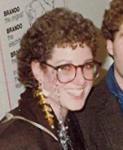
1983? C’mon, when are those glasses coming back?
Julie: My worst hairdo wasn’t my fault. It was a combo of the time, lack of product, and my hair itself. Back in high school and college my hair was crazy curly. (That is not a perm.) It was also the 80’s, which meant asymmetrical haircuts were the rage. Products weren’t what they are today. There were three choices, max. Hence, bad hair. But really good times.
Edith: Julie, are those six-inch long feather earrings? I kind of liked big glasses, too!
Sherry: If I ever say I want to cut off all my hair again please stop me. And what is with all the short bangs? 

Readers: Tell us about your worst hair-do!
Filed under: Group posts

February 10, 2015
Old Things
Edith barging in to say that Teresa Kander won the ARC of Farmed and Dangerous by commenting yesterday. Congratulations, Teresa!
By Sherry Harris where one day of spring-like weather disappeared faster than an ice cube in the Sahara
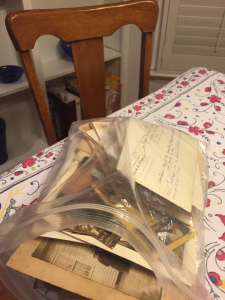 I was looking for a scrapbook I made when I was in third grade that was full of vintage valentines. I didn’t find the scrapbook but I did come across a bag of photos and postcards that were from my grandparent’s farm in Novinger, Missouri. I’m guessing keeping old photos in a plastic bag isn’t the smartest way to keep things. The chair in the background also came from my grandparents farm.
I was looking for a scrapbook I made when I was in third grade that was full of vintage valentines. I didn’t find the scrapbook but I did come across a bag of photos and postcards that were from my grandparent’s farm in Novinger, Missouri. I’m guessing keeping old photos in a plastic bag isn’t the smartest way to keep things. The chair in the background also came from my grandparents farm.
 I didn’t find a valentine but I found an Easter card.
I didn’t find a valentine but I found an Easter card.
This seems to be some kind of attendance record. Each airplane represents a day my dad attended Sunday School. There’s a whole stack of them — a fall one with squirrels, a 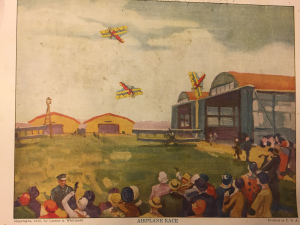 Christmas one with candles, one with cows, but I liked this one with the airplanes.
Christmas one with candles, one with cows, but I liked this one with the airplanes.
I found this picture of my grandfather in World War One. As I recall he was in New York City ready to board a ship for Europe but for some reason was pulled out and spent the 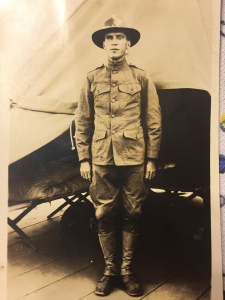 war in NYC. I think it’s where these postcards came from. I love the colors.
war in NYC. I think it’s where these postcards came from. I love the colors.
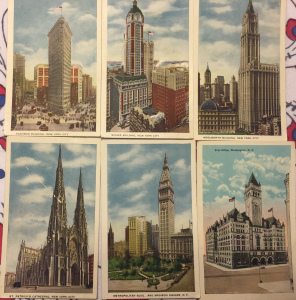 My dad served in World War Two. I think the first one was taken in Iowa City.
My dad served in World War Two. I think the first one was taken in Iowa City.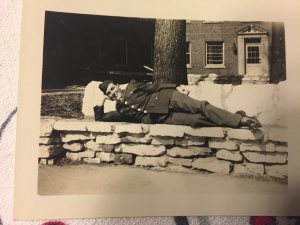 This one is in the Philippines. He spent the war at headquarters instead of in combat because he knew how to type and could run the teletype machine. But he told us a story of how he and his buddy hadn’t
This one is in the Philippines. He spent the war at headquarters instead of in combat because he knew how to type and could run the teletype machine. But he told us a story of how he and his buddy hadn’t  finished digging their foxhole and the Japanese attacked. The pictures below are self explanatory.
finished digging their foxhole and the Japanese attacked. The pictures below are self explanatory.
And a picture of me from college that was in the newspaper my grandparents subscribed to. Can you tell which one is me?
 Readers: Do you have a favorite old photo or postcard? What is it?
Readers: Do you have a favorite old photo or postcard? What is it?
Filed under: Sherry's posts Tagged: Army Song Book, City of Novinger MO, Novinger Missouri, vintage postcards

February 9, 2015
News for the History Books
Edith here, soaring with delight despite snow piles higher than my head, which are still rising as you read this.
First: Congratulations to Patricia Stoltey for winning a book from Catriona McPherson!
I have casually, some might say coyly, here and there mentioned my historical mystery series, the Carriagetown Mysteries. Well, today I am really exceedingly pleased to announce that I have signed a three-book contract with Terri Bischoff, Aquisitions Editor at Midnight Ink! (And yes, this does make three multi-book contracts. Gulp.)
I’m so pleased that my book-length stories of 1888 Amesbury, my fair city, are going to hit the hands of readers beginning a little over a year from now. To celebrate (besides the bubbly), I’ll give away an ARC of a totally unrelated mystery to one commenter today.
In the first Carriagetown mystery, Breaking the Silence, Quaker midwife Rose Carroll hears secrets and 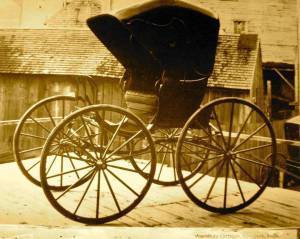 keeps confidences as she attends births of the rich and poor alike. When the town’s world-famed carriage industry goes up in flames (a true event in April, 1888), and a factory owner’s adult son is stabbed to death with Rose’s own knitting needle, she is drawn into solving the mystery of who set the fire and who killed the son. Things get dicey after the same owner’s mistress is also murdered, leaving her newborn infant without a mother. While struggling with being less than the perfect Friend, Rose draws on her strengths as a counselor and problem solver to bring two murderers to justice.
keeps confidences as she attends births of the rich and poor alike. When the town’s world-famed carriage industry goes up in flames (a true event in April, 1888), and a factory owner’s adult son is stabbed to death with Rose’s own knitting needle, she is drawn into solving the mystery of who set the fire and who killed the son. Things get dicey after the same owner’s mistress is also murdered, leaving her newborn infant without a mother. While struggling with being less than the perfect Friend, Rose draws on her strengths as a counselor and problem solver to bring two murderers to justice.

That little brass plaque reads, “Whittier’s Seat.” Picture by Kathleen Wooten.
Rose’s elder and mentor is the actual Quaker poet and abolitionist John Greenleaf Whittier, who lived in Amesbury and attended Amesbury Friends Meeting (the same Meetinghouse where I walk to and sit in expectant waiting on Sunday mornings). It’s been wonderful to research Whittier and bring him back to life, right down to the twinkle in his eye, his love for children, and his cane that was made from the Philadelphia building burned down by anti-abolitionists while he was in there working on his pro-abolition newspaper. His home, two blocks away from my own home, is now a living museum of which I am a member.
Rose lives with her dead sister’s brother and his five children in the very house I live in,  which was built in 1880 for the mill workers, so some of my research for the book is very easy and personal. I walk around town and visualize how it was without electric wires overhead or electric lights within. I imagine the many still-standing buildings housing the businesses of that era, and visualize structures no longer standing, like the Opera House.
which was built in 1880 for the mill workers, so some of my research for the book is very easy and personal. I walk around town and visualize how it was without electric wires overhead or electric lights within. I imagine the many still-standing buildings housing the businesses of that era, and visualize structures no longer standing, like the Opera House.
The late 1800s were a time of great change. Some towns and businesses might have had electricity and indoor plumbing, but not families of modest means like Rose’s. Germ theory was just being widely practiced. Midwives were beginning to be supplanted by doctors. The hospital across the river, where Rose’s romantic interest is a doctor, was only eight years old. You could buy ready-made shoes and clothes, and even a version of infant formula. At the same time, only twenty-two years had passed since the Civil War. Black people struggled. Women couldn’t vote or even run for office higher than the school committee. Police refused to get involved in domestic violence situations. It’s an exciting time in which to place a series.
Rose is an independent businesswoman who buys one of the new “safety” bicycles with wheels of equal sizes, and her good friend is postmistress Bertie Winslow, who rides a horse named Grover, after the President, and lives in a Boston marriage. But Rose is also a member of the Society of Friends, wearing plain dress and addressing people with thee and thy. She sometimes butts head with Irish police detective Kevin Donovan, and at other times is able to work with him to ferret out crime in the town.
who buys one of the new “safety” bicycles with wheels of equal sizes, and her good friend is postmistress Bertie Winslow, who rides a horse named Grover, after the President, and lives in a Boston marriage. But Rose is also a member of the Society of Friends, wearing plain dress and addressing people with thee and thy. She sometimes butts head with Irish police detective Kevin Donovan, and at other times is able to work with him to ferret out crime in the town.
I have two short stories out that pilot the setting and characters of the series: “A Fire in Carria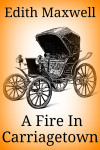 getown” (originally published as “Breaking the Silence” in Stone Cold: Best New England Crime Stories 2014 from Level Best Books), and “A Questionable Death” in the History and Mystery, Oh My! anthology from Mystery and Horror, LLC. But you’ll have to wait until March 2016 for the first book.
getown” (originally published as “Breaking the Silence” in Stone Cold: Best New England Crime Stories 2014 from Level Best Books), and “A Questionable Death” in the History and Mystery, Oh My! anthology from Mystery and Horror, LLC. But you’ll have to wait until March 2016 for the first book.
I’m so grateful to Terri and the Midnight Ink crew for taking me on. I’m grateful for readers who like historical mysteries. I’m hugely grateful to my local community, including the Amesbury Carriage Museum, the Whittier Home Association, and Amesbury Friends Meeting, who are all, as you can imagine, eagerly awaiting the first book. I’m terribly grateful to Ramona DeFelice Long, who greatly improved the manuscript for me with her editorial comments, and to Kathy Lynn Emerson, a successful historical mystery author, who shared her own historical research bibiolography and then offered a very positive pre-contracted endorsement of Breaking the Silence. Historical mystery author KB Inglee gave me some great tips on how life sounded and what things were called. And I’m always grateful for the Wickeds, and for all our wonderful blog followers. Thank you! Stay tuned for more about this series.
Now: Questions? I’m happy to talk about research, ideas, problems. Any of it! Ask away. I’ll give an ARC of Farmed and Dangerous to one commenter. And please raise a glass of the celebratory beverage of your choice with me sometime today.
Filed under: Edith's posts Tagged: Amesbury Carriage Museum, Carriagetown Mysteries, John Greenleaf Whittier, Kathy Lynn Emerson, Midnight Ink, Ramona DeFelice Long, Terri Bischoff, Whittier Home Association

February 6, 2015
Welcome Jane Haertel!
 We are happy to announce that Jane Haertel aka Susannah Hardy is joining our two other Wicked Accomplices, Sheila Connolly and Kim Gray, to do a monthly blog post. She will be with us on the second Tuesday of the month. Here is a little bit more about Jane:
We are happy to announce that Jane Haertel aka Susannah Hardy is joining our two other Wicked Accomplices, Sheila Connolly and Kim Gray, to do a monthly blog post. She will be with us on the second Tuesday of the month. Here is a little bit more about Jane:
I have the best job in the world: making up mysteries and inventing recipes to go along with them. But before that dream became a reality, I worked as a waitress, office underling, and handbag and window treatments designer and manufacturer. When I’m not writing stories, I operate Crazy Diamond Editing Services (www.crazydiamondediting.com), a full-service editing and coaching business. I’m a member of Sisters in Crime (New England Chapter) as well as Romance Writers of America, where I serve my local chapter (Connecticut RWA) as vice president of programming.
 A native of northern New York, I attended St. Lawrence University. I now live in Connecticut with my husband, teenage son, and Elvira the Wonder Cat. I also enjoy reading, knitting and crocheting, sewing, historical research, long walks, travel, and gardening.
A native of northern New York, I attended St. Lawrence University. I now live in Connecticut with my husband, teenage son, and Elvira the Wonder Cat. I also enjoy reading, knitting and crocheting, sewing, historical research, long walks, travel, and gardening.
My first novel, Feta Attraction, Book 1 of the Greek to Me Mysteries, is available now from Berkley Prime Crime at all major retailers. Book 2, Olive and Let Die, will release November 3, 2015.
Filed under: Jane's posts Tagged: Crazy Diamond Editing, Feta Attraction, Jane Haertel, Olive and Let Die, Susannah Hardy

February 5, 2015
Welcome, Catriona McPherson
Edith, who can tell by the giant piles of snow and the temperature outside she’s not in California anymore.
Catriona, we are so pleased to welcome you to the Wicked Cozy Authors ![1014280_529090457140360_828004586_n[1]](https://i.gr-assets.com/images/S/compressed.photo.goodreads.com/hostedimages/1423594000i/13648370.jpg) blog. For those who don’t know, Catriona [pronounced like Katrina] McPherson is an Anthony-, Bruce Alexander-, Macavity- and Agatha-award winning bestselling author and the current president of Sisters in Crime National. And she’s a funny, generous, lively person to spend time with. Catriona and I have a couple of unexpected things in common, and I was delighted that she agreed to let me interview her. So let’s get to know her even better. (And she’s promised to give away one of her fabulous books to a commenter, too!)
blog. For those who don’t know, Catriona [pronounced like Katrina] McPherson is an Anthony-, Bruce Alexander-, Macavity- and Agatha-award winning bestselling author and the current president of Sisters in Crime National. And she’s a funny, generous, lively person to spend time with. Catriona and I have a couple of unexpected things in common, and I was delighted that she agreed to let me interview her. So let’s get to know her even better. (And she’s promised to give away one of her fabulous books to a commenter, too!)
E: First, tell us why you write mysteries, and how you came to love the genre.
C: I’m circling my brain cell trying to remember the first mystery I ever read. I know I was reading Agatha Christie when I was an under-graduate, because a lofty fellow undergrad (male, need I say?) was withering about her. Not twice. I also adored Georgette Heyer’s detective stories and Ngaio Marsh too, Her Dottiness Dorothy L. Sayers, of course, Michael Innes . . . It was pretty well inevitable that when I started to write, I’d write crime. I love that the stakes are so high in crime fiction and that people reveal themselves in tight jams. A bit of me likes to dig into the worst of humanity and poke around there seeing how it works. But also, there’s the escapism of resolution – what Jill Paton Walsh called “a dream of justice”. Life is so rarely like that, but in our books we can have right prevail.
E: You write the Dandy Gilver books, a long-running historical mystery series that I’m woefully behind on, featuring an upper-class Scottish woman in the early 1900s who has a bent for solving crimes. Tell us how you conceived of her and why you set the series when you did.
C: I set it in the golden-age for British detective fiction rather than in a real historical period. And actually pretty early, starting in 1922, because I wanted time to pass between books and I didn’t want to crash in WWII. It seemed a wee bit conceited at the time but here I am, writing book eleven, set in 1932 – in other words, more than halfway there. I worry, because she’s got two teenage sons and here it comes.
Ha! That last sentence’ll make it hard for me to claim she’s not a real person in my mind, eh?
I started out quite mechanically with a clip-board and a biro [E: um, that’s a ballpoint pen] (on the beach (in Scotland, so well wrapped up)) to work out who my detective was going to be. Female, rich because poor women were so constrained then – not much time to solve crime after a twelve-hour shift in a linoleum factory, married because married rich women were free to do as they chose after they produced the heir and the spare. Hence the sons. I sometimes regret her poshness. I’m not at all posh and not that sympathetic to the concerns of 20th century aristocracy either, but it’s a lot of fun putting her in situations where she has to broaden her ideas. The thing I really regret is giving her a dog. Think about it: she started with a six-year-old Dalmatian and it’s eleven years later . . . the latest book was hard to write.
E: I also write an historical mystery series, set several decades before yours and in New England. Tell us a bit about how you do your research, and what your best sources have been.
C: I’m filled with awe for your research, Edith. Mine is much easier. Well, suddenly moving to California wasn’t a clever step, but generally Scotland now looks a lot like Scotland in the 1920s, and the 1820s . . . and also I spent a wonderful couple of years working in the local history archive at Edinburgh City Library. That was a great training in how to get social history out of documents and photographs. I love to put together an Ordnance Survey map and a Post Office Directory so I 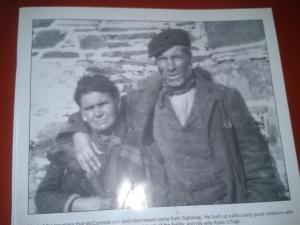 know who was living where in some little town and what shops were at the end of the street. Newspapers are my absolute favourite resource. Not the big news stories, but the adverts, personal ads and editorials. And photographs. I spend a lot of staring into the eyes of long-dead strangers.
know who was living where in some little town and what shops were at the end of the street. Newspapers are my absolute favourite resource. Not the big news stories, but the adverts, personal ads and editorials. And photographs. I spend a lot of staring into the eyes of long-dead strangers.
E: Totally agree about the little bits in the newspapers: the price of shoes, what was playing at the opera house. But you also write these fabulous standalone suspense novels from Midnight Ink. Isn’t it hard to create an entire new world every time you write a standalone? Have you considered spinning one of them, like Jessie Constable in The Day She Died, into a series?
C: Well, thank you! That’s very kind of you. And here’s a secret. I cheat. A lot. The beach in The Day She Died is the same beach where I sat with my clip board dreaming up Dandy Gilver. And the house in As She Left It is my friend Diane’s house. She read the book sitting in the house. I’m very proud that I freaked her out so much she had to lock the doors and check the cupboards.
I know what you mean about letting them all go. I miss Jessie. But her story is told. Maybe, years down the line, she might fall into another patch of trouble but what I love about standalones is that you can thrash your characters to bits and leave them reeling. They don’t need to be functioning for a book every year.
E: Thrashing characters to bits. I like the sound of that! After you so kindly sat at my table at the New Author breakfast at Malice Domestic a couple of years ago (the morning after you’d won the Agatha!), you told me that, like me, you also hold a PhD in linguistics. Why did you leave that world?
C: I remember it – what an energy in that room! I enjoyed doing the PhD and can always win hands-down at any competition to find the most useless-sounding thesis. (I built a possible worlds theory of the interpretation of references to non-existent objects. Beat that.) But I did it in what must have been the warmest, fuzziest university department ever – linguistics at Edinburgh. When I got a job as a professor in a normal university department, with all the back-biting and one-upmanship, I started to wither. My love of semantics couldn’t make up for having colleagues who didn’t say hello when we passed in the hallways. So I packed it in to write stories and make up my own people. It wasn’t a classic career move, but it’s going okay.
E: I should say it IS going okay! And yes, you’ve got my thesis beat (A Study Of Misarticulation from a Linguistic Perspective). You’ve lived in California, my home state, for five years. Davis is dry and hot and, well, California. What’s been your hardest adjustment to leaving Scotland? What’s easier in the Golden State?
C: Gliding around on straight flat roads with no frost in an automatic car is easier than struggling up and down vertiginous lanes over black ice with a stick shift!
Apart from separation from loved ones, the hardest adjustment has been . . . oof, is it the dialect chasm? I got used to the three tiers of shopping failure: A. what words am I saying? B. that’s not what it’s called, and C. they haven’t got it. (Curry paste, riddles, double cream . . .) Which brings me onto the other thing – the unavailability of some foodstuffs I grew up on. Now, California has better oranges and watermelons than Scotland – don’t get me wrong! – but sourcing the ingredients for haggis is an adventure. Never foresaw perfecting the Spanish for sheep’s stomach and kidney caul fat so early on in my learning. (Mexican butchers are the bomb.)
E: Kidney caul fat – never heard the term before, although since I write about a traditional midwife, I know what a caul is. But what are riddles? Okay, I googled it. Still not sure. A sieve? A colander?
C: Ha! See what I mean? It’s a big round sieve for “riddling” weeds out of soil or soil out of gravel.
E: Now, what’s next? What are you working on now, and when are your next books coming out?
C: Boysie-boy, this year is nuts. Right now I’m writing Dandy Gilver No.11, as I said, knocking out the first draft. Next up I’m going to write standalone No.5 and before the end of December I’m planning to write something completely new. (It’ll be fine.) Sorry to be mysterious but I never talk about books until the first draft is done.
However, I can talk about the books coming out this year – another three. (It’ll be fine; it’ll be fine.)
In May, it’s COME TO HARM, a standalone from Midnight Ink. I’m looking over 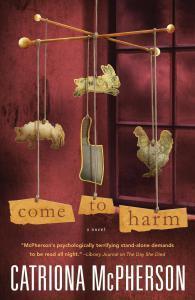 page proofs now. It’s the story of Keiko Nishisato who moves to Edinburgh to study for a PhD (I couldn’t have done it without the help and friendship of Etsuko Oishi, Mariko Kondo and Yuko Kondo who were there with me in the 90s – cheating, see?) and finds herself living above a butcher’s shop in a very friendly little town. Too friendly? We’ll see . . .
page proofs now. It’s the story of Keiko Nishisato who moves to Edinburgh to study for a PhD (I couldn’t have done it without the help and friendship of Etsuko Oishi, Mariko Kondo and Yuko Kondo who were there with me in the 90s – cheating, see?) and finds herself living above a butcher’s shop in a very friendly little town. Too friendly? We’ll see . . .
In July, DANDY GILVER AND THE UNPLEASANTNESS IN THE BALLROOM is published in the UK. It’s 1931 and Dandy and Alec are in Glasgow at the height of that city’s dance fever, trying to stop a professional ballroom and Latin competition descending into bloody murder. Between traditional Glasgow/Edinburgh rivalry and foxtrot steps, it was a lot of fun to write. I can’t wait to see the cover.
In September comes THE CHILD GARDEN – another standalone from Midnight Ink. This is the extra one. It’s a hardback coming out to help celebrate MI’s tenth anniversary. Cheating again, I’ve set this in my house in Galloway and it was a treat to go back there. In TCG, Gloria Harkness, single parent of a profoundly disabled teenaged son, answers the door one night and finds Stig Tarrant, who sat beside her at school when they were ten and who was her first love. He’s soaked through and terrified and she doesn’t pause for a minute before letting him in . . . how could it go wrong?
And then in November . . . wait a minute! This makes four. (It’ll be fine) but I’m stopping before my ears bleed.
E: I am blown away by your year. Four books? You’re amazing. And you’re right, it’ll be fine. ;^) Anyway, thanks SO much for hanging out at the Wicked Cozy water cooler today, Catriona. Final question: when are you coming to the New England Crime Bake? We’d love to have you.
C: Oh, me too. So much. But you’ll understand if it’s not this year, right?
E: I don’t know. SINC presidents have been making an appearance every year now. No pressure, but…
Readers: Questions for Catriona? Accolades? Admiring comments? All are welcome! Remember, one of you will win a book from Catriona!
Filed under: Guest posts Tagged: Agatha award, As She Left It, Catriona McPherson, Dandy Gilver, Midnight Ink, Scottish mystery, The Day She Died

February 4, 2015
Wicked Wednesday-What’s Your Lucky Charm?
Jessie: Feeling lucky despite the weather!
In continuing our Wicked Celebration of the release of Sheila’s latest County Cork Mystery, An Early Wake, we’re talking about luck today, Irish or not.
From four leaf clovers to rabbit feet, lucky charms are everywhere. Some people believe wholeheartedly. Some people scoff and sneer. Others sit carefully perched in the middle of a fence. So Wickeds, do you have a lucky charm? A good luck ritual? A talisman? A totem? Or do you think such things are mere Dumbo’s Feathers and don’t feel the need of them?
Edith: For decades I carried a little Good-Luck-in-Driving charm in my purse. This omamori was given to me when I taught English in Japan.  It seems to have gone missing, though, so I guess it’s good that I no longer commute to a job every day. I also learned in Japan never to leave chopsticks stuck into a bowl of food, because that is only done for dead people. You always lay chopsticks across the top of the bowl. I guess that’s the flip side of a lucky charm.
It seems to have gone missing, though, so I guess it’s good that I no longer commute to a job every day. I also learned in Japan never to leave chopsticks stuck into a bowl of food, because that is only done for dead people. You always lay chopsticks across the top of the bowl. I guess that’s the flip side of a lucky charm.
And even though my mother is no longer alive, I still avoid treading on cracks in the sidewalk, a habit I’ve had since childhood after learning this saying: “Step on a crack, break your mother’s back.” You just don’t want to tempt fate that way!
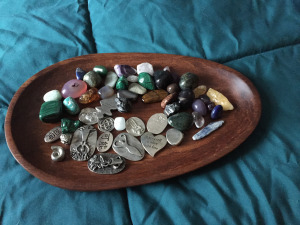 Liz: I’m a huge believer in crystals and gemstones, and have a collection of them. Each of them means something different and is believed to help boost those areas where you need the most help, from the physical to the emotional. I choose one stone per day based on
Liz: I’m a huge believer in crystals and gemstones, and have a collection of them. Each of them means something different and is believed to help boost those areas where you need the most help, from the physical to the emotional. I choose one stone per day based on 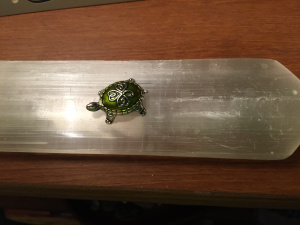 how I’m feeling. I’ve also been carrying the lucky Irish turtle around lately – mostly because he’s cute!
how I’m feeling. I’ve also been carrying the lucky Irish turtle around lately – mostly because he’s cute!
Sherry: It’s not exactly a lucky charm, but my husband gave me a necklace right after our daughter was born twenty-two years ago. I wear it almost every day and especially on days when I’m feeling stressed. I’ve had a couple of near misses with losing it but so far (knock on wood — I’m not superstitious at all) someone has always found it.
Julie: I have a couple of talismen that bring me luck. Or, more accurately, give me a sense of peace when I see them or look at them. I don’t have any specific rituals regarding luck, mostly because if I lose the earring or the lucky shirt isn’t clean, I don’t want to go into a tailspin. BUT my theater life does feed into my civilian life. I never wish someone “good luck”, or if I do, I feel strange. “Break a leg” is my go to. I never say “Macbeth” in a theater. And if I could whistle, I would never do it back stage.
Barb: I had a hard time with this one. I have many comfort objects, things that are sentimental for me, displayed around my house. I have things I am rarely without, like my Levenger Junior notebook with my calendar, to do lists, notes, etc, a version of which I’ve had in my possession for a decade. But in terms of things specifically designed to be good luck, I don’t have any focused on my luck. I do have some focused on the luck of loved ones, probably because the less control I have, the more I’m willing to give over to luck.
Jessie: I don’t usually depend on luck. I am more of a preparedness sort of person. That being said, I do have an amethyst pendant I tend to wear any time I might want an ace in the hole. It is actually a dowsing pendulum on a chain and it provides the added function of being something to play with if I get stuck somewhere unexpectedly without a book or some knitting.
Readers how about you? Do you believe in the power of lucky charms?
Filed under: Group posts, Jessie's posts, Wicked Wednesday Tagged: four leaf clovers, lucky charms, omamori, rabbit's feet, rituals, talisman, totem

February 3, 2015
Happy Book Birthday — An Early Wake by Sheila Connolly
Happy Book Birthday to Sheila Connolly. An Early Wake is the third in Sheila’s wonderful County Cork Mystery series.
Pub owner Maura Donovan may have Irish kin, but she doesn’t seem to have the luck of the Irish. Who could have foreseen that bringing live music back to Sullivan’s Pub would lead to a dead musician?
Summer is ending in County Cork, Ireland, and with it the tourist season. Expat Maura Donovan is determined to keep Sullivan’s Pub in the black as the days grow shorter—but how? When she hears that the place was once a hot spot for Irish musicians who’d come play in the back room, she wonders if bringing back live music might be Sullivan’s salvation.
As word gets out, legendary musicians begin to appear at the pub, and the first impromptu jam session brings in scores of music lovers. But things hit a sour note when Maura finds a dead musician in the back room the next morning. With a slew of potential suspects, it’s going to take more than a pint and a good think to force a murderer to face the music.
Liz: Happy book birthday, Sheila! I love this series – both the story and the setting. Since I don’t get out much, it’s the perfect way to take an annual trip to Ireland :) Can’t wait to read!
Barb: Authors can’t have favorite children, but fans can. This is my absolute favorite of Sheila’s three series. Preordered. Can’t wait.
Edith: Yay, Sheila! My copy already arrived and is right there on the very top of my TBR pile. I’m determined to get to Ireland sometime in the next few years, too, and will absolutely visit County Cork and your pub.
Jessie: Congratulations, Sheila, on another release and another gorgeous cover! Wishing you many more of each!
Sherry: I get to make another trip to Ireland through this series! I hope to make a real one someday soon but until then…
Julie: I love this series! It is both familiar and foreign, and a wonderful place to visit on these bleak winter days. Congratulations Sheila!
Filed under: Book Release Tagged: A County Cork Mystery, An Early Wake, Ireland, sheila connolly

February 2, 2015
Seeing a Story
by Sheila Connolly
I’ve been trying to remember when I got my first camera—I think was I seven or eight. My father was the picture-taker in the family. He had an SLR (long before I had a clue what that was), and we had an 8-mm movie camera (which took only 50 feet of film at a time, and my father took a lot of pictures of sunrises over the Atlantic Ocean), and a top-view Roliflex, and even a stereo camera and one of those viewers (the pictures and the viewer are in my attic—the camera is long gone). Oh, and a Polaroid, as soon as they came out. Of course, nobody else was allowed to touch them.
I received a Brownie, one of those clunky but sturdy brown plastic ones. I can’t say I used it a lot: film was expensive, and it took time to get it developed (we didn’t live near town), and if I recall correctly it took only 12 pictures at a time. Not exactly kid-friendly, eh? Certainly not by today’s standards.
Do I have a point in here? That has anything to do with writing? I think so. I have a strong visual memory (which probably explains why I was an art historian for several years of my life), and to reinforce that I take pictures so I can revisit those memories. But—surprise!—it works for a writer too.
People who are not writers often ask, “how do you do it?” Well, to me it’s simple: I see and hear the story, scene by scene. I can walk through a place in my head, like it was a three-dimensional stage. Of course, I usually borrow real places—I don’t just make them up. I’ve stayed overnight in the house that is the focus of the Orchard mysteries; I worked in Philadelphia for several years. And I’ve spent time in the pub that is the heart of the County Cork series, starting in 19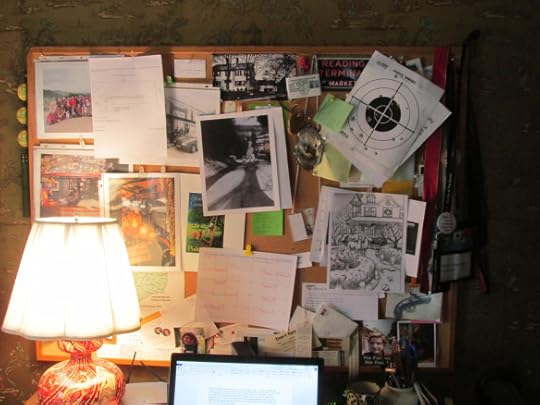 98 (!), so I can describe the layout accurately.
98 (!), so I can describe the layout accurately.
I’ve heard other writers say that they create whole scrapbooks for their characters and settings. I don’t go quite that far. I do have a large corkboard over the desk where I work, filled with pictures that speak to me, that are iconic for each of my series. Of course, there’s a whole lot more jumbled together: the last target I used when I went shooting with friends (yes, I have a permit), various book covers, a calendar (essential!) and assorted appointment reminders, and other things that I just plain like to look at. Poor overloaded corkboard: every now and then I have to strip everything off and start over, because it’s so jammed up.
But I also take detailed pictures of the places I use. For the house in the Orchard series, I’ve visited the basement and the attic. I go back to Philadelphia at least once a year, to see what has changed—which buildings have gone up or been torn down. While I’m there I also walk between sites I use in the series (like police headquarters and my not so mythical Society building), and throw in a few restaurants and hotels as well, so I get distances right.
And then there’s County Cork. So many people have commented that I make the place come alive for them—they can see it, and they want to be there. That’s because (a) I love the place, (b) I spend as much time as I can there, just looking and listening, and (c) I take pictures. So to celebrate the release of An Early Wake tomorrow (!), let me show you some of the details (not just the lovely scenery or the rainbows) I collect along the way, that make a place real when you include them in a book.

Available everywhere (I hope) tomorrow, February 3rd.
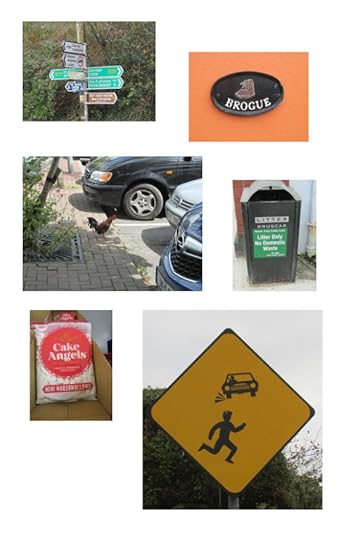
Pictures from West Cork (and no, I don’t know what the traffic sign means!)
Filed under: Craft, Sheila's Posts Tagged: County Cork Mysteries, sheila connolly


